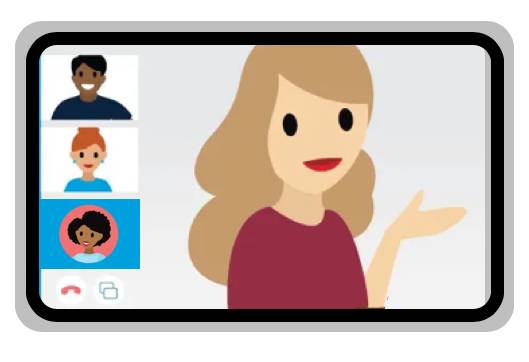Engage with Your Audience
Learning Objectives
After completing this unit, you’ll be able to:
- Identify six vocal presentation tips.
- Explain how body control helps both on- and off-camera.
- Describe the two ways to work with teammates during a presentation.
Now Hear This
Think about your local news program. Chances are the anchors aren’t the most exciting speakers. They read the news as written with no emotion or character in their voices.
Your voice makes up 80 percent of your personal impact during a remote presentation. In other words, give your audience a performance worth listening to, or else they won’t want to hear what you say.
It’s not as hard as it sounds. The first step is to talk to your customers as if they were in the room. That means:
- Speak naturally like the interesting human being you are.
- Keep your composure to sound clear, strong, credible, and compelling.
- Be genuinely passionate and have fun. The audience can tell!
Six Tips to Sounding Better
Want to make your vocal performance ready for prime time? Here are the six things that give you an award-winning voice.
- Modulation. Change up your tone to keep it interesting and engaging. A monotone voice puts audiences to sleep.
- Pace. Keep a comfortable pace, and vary it to match the topic. Don’t speak so fast that you sound nervous or so slow that you put the audience to sleep.
- Pause. Take a pause after making a key point or bringing up a new slide to let your audience process the new information.
- Words. Put as much thought into the words you say as the words on your slides. Keep your language clear, to the point, and free of slang, internal terminology, or abbreviations.
- Confidence. You know your stuff. Let your voice reflect this. Avoid using non-words—such as, um and ah—and unnecessary filler words—such as, so, like, and you know.
- Enthusiasm. Show how genuinely excited you are with your subject. And remember to smile. Trust us, the audience can hear the smile in your voice.
Body Language
Even if you’re not there in person, your body language speaks for you. In fact, your body language says a lot even when you’re not on camera. Oh yes. Your audience can hear your body, and not just your stomach rumbling.

Good body language enhances your speaking voice. When you present:
- Stand or sit forward in an engaged posture with your weight balanced and your feet flat on the floor.
- Use gestures to add emphasis and to help get rid of any nervous energy.
Your audience will really hear the difference in your vocal projection and inflection.
Oh, and floss first. Don’t let some spinach stuck in your teeth become the star of your speech!
Meet Your Co-Stars
Nobody said that presentations have to be a one-person show. Just like the set of a television show, a good presentation is made better when teammates help you both in the field and behind the scenes.
Behind the Scenes
For meetings with chat—especially with larger audiences—you absolutely need a teammate monitoring what people say. If you try to do it yourself, you may lose focus or miss key questions. Having an expert at the keyboard gives you the freedom to concentrate on staying connected.
A great monitoring teammate knows when to answer a question privately and when to pass the question on to you. Plan a way for your teammate to send you customer questions that get your attention without distracting from your presentation. An on-screen message or a messenger chime will steal your audience’s attention, so consider using a simple method like a shared Quip document on a second device.